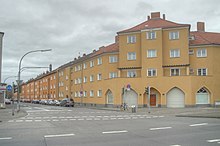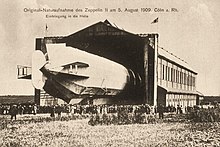Bickendorf (Cologne)
|
Bickendorf district 403 of Cologne |
|
|---|---|
| Coordinates | 50 ° 57 '27 " N , 6 ° 54' 1" E |
| surface | 2.31 km² |
| Residents | 16,556 (Dec. 31, 2017) |
| Population density | 7167 inhabitants / km² |
| Incorporation | Apr 1, 1888 |
| Post Code | 50827 |
| prefix | 0221 |
| Borough | Ehrenfeld (4) |
| Transport links | |
| Federal road |
|
| Light rail lines | 3 4th |
| Bus routes | 139 140 141 143 |
| Source: 2017 residents . (PDF) Cologne district information | |
Bickendorf is a district in the northwest of Cologne in the Ehrenfeld district . The name Bickendorf probably comes from the Franconian word beck for mouth, saying, court judgment or place of jurisdiction . The district changed its village character mainly through extensive workers' settlements that emerged at the beginning of the 20th century, and towards the outskirts through an industrial area.
location
The district of Bickendorf borders in the north and northeast on Ossendorf , in the southeast and south on Ehrenfeld and in the west on Vogelsang .
history
The area of what is today the Bickendorf district was already settled by the Germanic Ubi people a few decades before our era, as archaeological finds show. It is believed that later on or near the settlements in the area of Bickendorf and the neighboring Ossendorf there was a Roman estate.
It is certain that there were monastery properties in Bickendorf very early - from the 13th century onwards. These are considered to be the actual beginnings of Bickendorf and Ossendorf.
Over the centuries, Bickendorf remained a farming village with a few hundred inhabitants, which ecclesiastically belonged to the parish of St. Bartholomew on the Mechternhof , one of the three estates on the site of the later Ehrenfeld. Administratively, Bickendorf belonged to the hereditary bailiff of Cologne and to the judicial district of Gereonis. The Hofgut Chapel with inscriptions in honor of the patron saint against the plague, St. Rochus , was built in 1733. Between 1836 and 1847 it was used as a parish church and, after being partially destroyed in 1842, rebuilt in a shortened form and restored in 1925. It is located on today's Venloer Straße . Although belonging to the Mechternkirche, the Bickendorfer attended the early mass held by the Franciscans in the Rochus Chapel.
In 1838 they began planning their own church - St. Rochus - which was completed on August 12, 1849. The Mechternkirche was demolished in 1802 as part of the French occupation and the associated secularization . The church consecration of the Rochuskirche took place 20 years later on October 9, 1869 by Auxiliary Bishop Baudri .
When Ehrenfeld was founded in 1843, Bickendorf had 345 inhabitants and, like all of Ehrenfeld, belonged to the mayor's office of Müngersdorf; Growth started quite suddenly around 1915, when the non-profit corporation for housing (GAG) planned 578 workers' apartments in Bickendorf. In an architecture competition, a group of architects with Wilhelm Riphahn and a design under the Cologne motto "Lich, Luff und Bäumcher" (light, air and little trees) won. Mostly single-family houses were built, which at the beginning were mainly occupied by large families. From 1920 onwards, these buildings were supplemented by numerous single and multi-family houses, which the Kölner Gartensiedlung housing cooperative built again with Riphahn.
In 1935, the city of Cologne established the " Gypsy camp Cologne-Bickendorf " on the grounds of the Schwarz-Weiß sports club , in which people referred to by the National Socialists as " Gypsies " were forcibly resettled in barracks under supervision in order to keep them from wandering. In 1937 about 500 people lived there. After initially unemployed inmates of the camp were brought to the Sachsenhausen concentration camp in 1938 , the camp was completely dissolved on May 16, 1940 and the residents were transported to the assembly camp in Cologne-Deutz , from where they were deported to eastern Poland five days later. After the war, a trailer camp was again built on the site. In 1958 the city in Cologne-Roggendorf created living space for the residents. In 1990 the artist Gunter Demnig drew a trace of writing - MAY 1940 - 1000 ROMA AND SINTI - from the site in Bickendorf through the city center to the Deutz trade fair. In March 2001, a memorial plaque was also erected at the intersection of Venloer Strasse and Matthias-Brüggen-Strasse, commemorating the Bickendorf “gypsy camp”.
During the Second World War, the St. Rochus Church was completely destroyed by several bombing raids in 1942 and 1944. After the war, the reconstruction began and in 1949 the new church was consecrated in the same place.
Demographic statistics
Structure of the population of Cologne-Bickendorf:
- Proportion of under 18-year-olds: 18.2% (2014)
- Proportion of over 64-year-olds: 15.9% (2014)
- Proportion of foreigners: 22.5% (2015)
- Unemployment rate: 12.5% (2014)
architecture
From 1923 onwards, the so-called Rosenhof settlement in the New Objectivity style , designed by the architects Caspar Maria Grod and Wilhelm Riphahn, was built under the name "Bickendorf II" and is considered a "remarkable example of settlement construction in the 1920s". The settlement with its center, the Catholic Church of St. Dreikönigen , is a bit more urban and representative than the earlier built, more rural GAG settlement Bickendorf I. Since 1996 it has been listed as an ensemble with the number 8024 .
Approx. In 1927, the architects created three painting studios for artist friends in the attic of the residential buildings and a sculptor's studio in a planned passage on Akazienweg. A number of well-known artists worked here, including a. the Dadaist graphic artist Marta Hegemann and her husband Anton Räderscheidt , members of the group " Kölner Progressive ". The studios have been used continuously up to the present day and were only dismantled during a renovation in 2012 for fire protection reasons.
Former airship port
After the city of Cologne forbade Jean-Pierre Blanchard to launch a balloon in October 1785 , Cologne only developed its own aeronautical activities in modern times , when the "Cölner Club für Luftschiffahrt eV" was founded on September 9, 1906. It still exists today under the name " Cologne Air Sports Club ". This club started on February 9, 1907 for the first time with a balloon from Cologne-Deutz . On April 1, 1909, construction began on the "Reichs-Luftschiffhalle" in Cologne-Bickendorf between Venloer Strasse and Ossendorfer Weg. A steel structure, 152 meters long, 50 meters wide and 30 meters high (hall area 7600 m²) is being built. It was completed in May 1909 and offered space for 3 airships . The airship hangar was in Cologne-Bickendorf and not - as is often claimed - at the Butzweilerhof in Cologne-Ossendorf . In July 1909, Kaiser Wilhelm II gave the city of Cologne the official name “Reichsluftschiffhafen Coeln”. Count Ferdinand von Zeppelin landed on August 5, 1909 with the "Z II" in Cologne-Bickendorf. From April 1910, maneuvering operations with the airships "Z II", "MI" and "P II" were taken from the airship port in Cologne . At the beginning of 1912, four cantilever hangars, each 22 × 60 meters, were built. The buildings were closed from 1970.
traffic
The station Köln-Bickendorf is a freight station on the railway line Cologne-Frechen .
Personalities
- Jerzy Gross (1929 - 2014), one of the Schindler Jews , spent his old age in Bickendorf. A memorial plaque was erected at his last place of residence.
See also
literature
- Christian Schuh: Cologne's 85 districts. Emons, Cologne 2003, ISBN 3-89705-278-4 .
Web links
- Official website of the city of Cologne for the Bickendorf district
- 154 years of the parish church of St. Rochus
Individual evidence
- ↑ Inhabitants according to selected age groups - data source: City of Cologne - offenedaten-koeln.de
- ↑ Inhabitants according to selected age groups - data source: City of Cologne - offenedaten-koeln.de
- ↑ Inhabitants by type of migration background - data source: City of Cologne - offenedaten-koeln.de
- ↑ Employed and unemployed part of the city - data source: City of Cologne - offenedaten-koeln.de
- ↑ a b Felix Klopotek: The avant-garde under the roof. In: stadtrevue.de. June 2017. Retrieved January 25, 2018 .
- ↑ Editorial office baukunst-nrw: Housing estate "Bickendorf II" (Rosenhofsiedlung). In: baukunst-nrw.de. Chamber of Architects North Rhine-Westphalia, accessed on January 25, 2018 .
- ^ Angelika Rheindorf: studios of well-known artists . In: Kölnische Rundschau . No. 281 . Cologne December 2, 2010, p. 50 ( online [PDF]).
- ^ Thomas Piepenstock: Artist studios in Cologne-Bickendorf 1927 - 2011 . Documentation of the uses, residents, "renovation" and the role of the GAG. 2009, p. 15 ( online resource [PDF]).
- ^ Jürgen Eichler: Airships and airship travel. 1993, p. 103.





